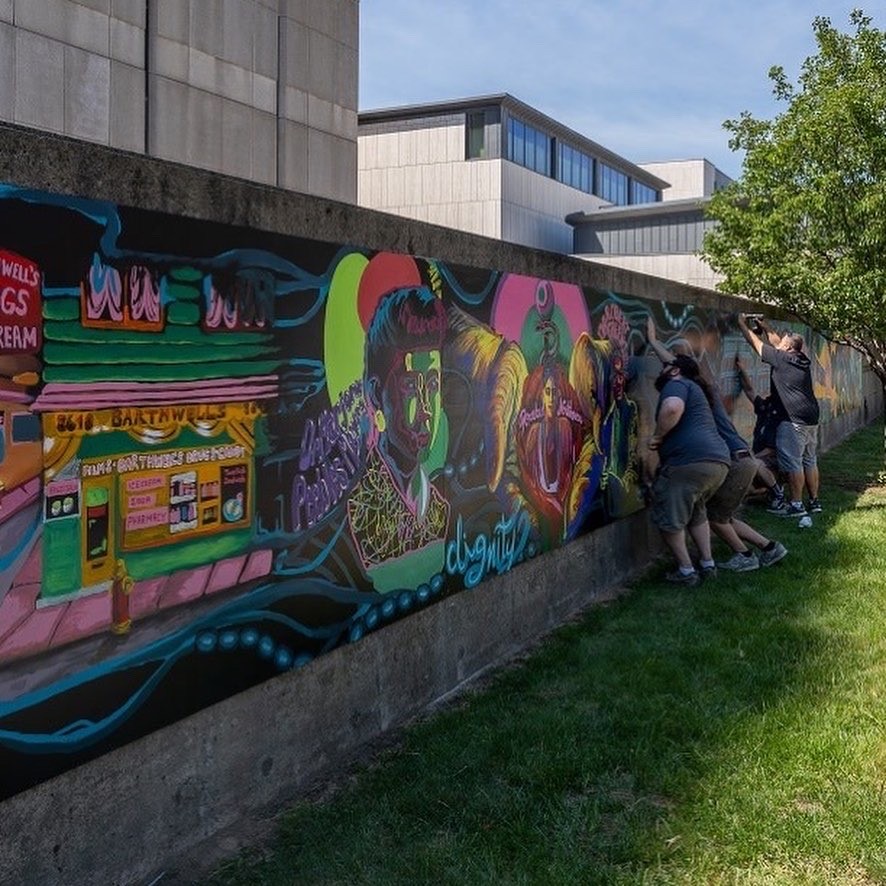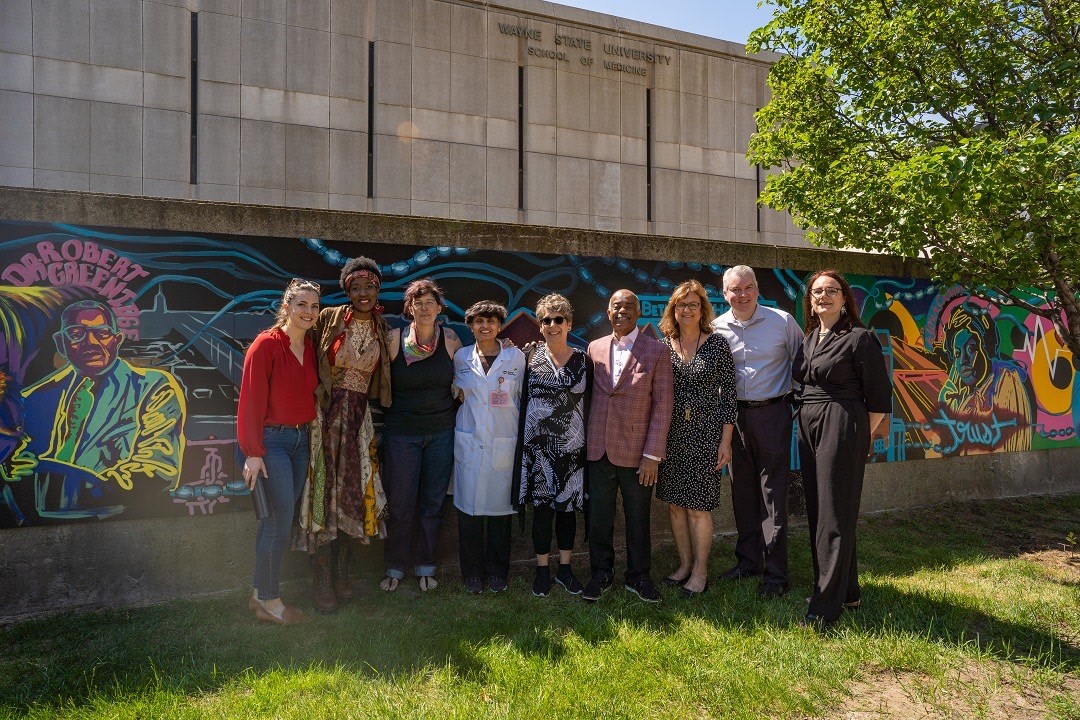New mural brightens medical campus, offers history lesson – School of Medicine News

[ad_1]

Motorists and pedestrians on East Canfield west of St. Antoine Street now have a more colorful drive and walk – along with a history lesson – thanks to a massive newly-installed mural.
The mural, the product of a public humanities initiative to connect a multidisciplinary team of physicians, artists, students and activists with the broader community to celebrate the history of diversity in medicine and public health at Wayne State University and in the city, was installed on the 375-foot-long public-facing concrete wall along the sidewalk north of Scott Hall, on the south side of Canfield Street, on June 13.
The Wayne State University School of Medicine’s Office of Faculty Affairs and Professional Development partnered with the WSU Arts Department in the College of Fine, Performing and Communication Arts to design the artwork. WSU fine arts students designed the mural, based on oral histories of community members with deep roots to the location on which the School of Medicine sits. The area is the former site of the Plymouth Congregational Church in Detroit’s historic Black Bottom and Paradise Valley neighborhoods. The mural is intended as a monument to African American progress in the medical field, in Detroit and within the global community.
In 2019, Painting and Drawing Professor Margi Weir had a vision for a mural painting course. She shared that vision with department Chair Sheryl Oring, and students have been making – and capturing – history since then.
There is now a collaborative working group called the Arts Integration in Medical Education, spearheaded by Oring, chair of the James Pearson Duffy Department of Art and Art History; Beena Sood, M.D., associate dean for Professional Development at the School of Medicine; and Grace Serra, WSU Art Collection curator. “We have gathered an incredible group of active collaborators on this project, which demonstrates just how integral it is to addressing some of the most important issues of the day,” Oring said. “Art can play a critical role in helping us see things in new ways, hone observation skills and provide a means of healing.”
Cara Young and Ephemera Fae, master’s of fine arts students in the Art and Art History Department, and Ashley Kramer, an M.D/Ph.D. student at the School of Medicine, were involved in the planning and executing of the mural, and also ran workshops with a cohort of medical students on visual thinking strategies, gesture drawing and gross anatomy drawing.
Jennifer Mendez, Ph.D., associate professor emeritus, Internal Medicine and director of Community Engagement Programs, spearheaded a multidisciplinary research study that was funded by the Association of American Medical Colleges. The study included Fae and Young who, utilizing art from the WSU Art Collection, have facilitated visual thinking strategy sessions to train medical students to develop more acute visual literacy. The visual literacy training helps medical students in a range of areas, including better interpretation of ultrasound images and developing implicit bias awareness when assessing patients.
When she chaired the Women in Medicine and Science group, Dr. Sood facilitated a journal club organized by the American Medical Women’s Association. The club discussed an article in the Journal of the American Medical Association titled “Deck the Halls with Diverse Portraits,” which analyzed how murals in medical schools tended to promote racial stereotypes and implicit bias. It argued for the need to display diverse teams in schools of medicine and academic health centers.
“That article left a deep impact on me,” she said. “Those of us in the journal club thought that it would be great to have a mural in our school that displayed the true diversity of our profession.”
Dr. Sood brought these ideas forward with the collaboration with Oring, Serra, and the Art and Art History Department. She learned that the College of Fine, Performing and Communication Arts and the Art and Art History Department were looking to collaborate with the School of Medicine.
 The mural, supported by a grant from the Michigan Humanities Council, honors the history of diversity in medicine and the impact of African American health care leaders in Detroit and today. The mural also celebrates the role of the School of Medicine and the Detroit Medical Center in shaping health care and public health.
The mural, supported by a grant from the Michigan Humanities Council, honors the history of diversity in medicine and the impact of African American health care leaders in Detroit and today. The mural also celebrates the role of the School of Medicine and the Detroit Medical Center in shaping health care and public health.
“Our hopes are that this will reveal the important symbiotic relationship between the university and the broader community, and use it to serve as a bridge to creating a better future,” Serra said. “Art is the necessary tool to tell these stories.”
Community participation played a critical role in the project.
“We knew that we needed to have community involvement in this project, and it was essential to include their voices,” Dr. Sood said. “We want to break down any walls between Wayne State University’s School of Medicine and the people we serve, and this project can be a means to make that connection.”
Serra conducted oral history interviews while Young and Fae held listening sessions with medical students to help develop the mural concept. Serra worked with community leaders Rev. Jimmy Womack and Rev. Nicholas Hood of Plymouth United Church of Christ on St. Antoine Street to connect with congregation members and conduct the oral history interviews. The church, situated around the corner from the School of Medicine, has strong historic ties to Dunbar Hospital. Built in 1892, Dunbar was the first hospital for the Black community in Detroit. At that time, “Black physicians could not practice, and Black patients would not be admitted, to white hospitals. A strong community built up connected to Black Bottom and Paradise Valley, which was right around the corner from Paradise Theater and the Gotham Hotel. These were all very important and famous sites,” Serra said.
One oral history participant is a descendent of Daisy Hill Northcross, M.D., a key figure in Detroit’s history of medicine. Dr. Northcross, the second Black woman to apply for a medical license in Alabama, migrated from Montgomery to Detroit in 1916. The following year, she and her husband, David Northcross, opened the city’s first Black-owned and -operated hospital, Detroit Mercy General Hospital, which paved the way for Dunbar Hospital, where many eminent African-American physicians would get their start. The Northcrosses also opened a nurses training center, a hotel and a store. Dr. Daisy Northcross is commemorated in the mural.
Fae said the mural celebrates both the people of Black Bottom who lived in the location of the School of Medicine as well as the ongoing impact of Detroit’s medical community.
“We want to remember that this is a place that was connected to Black Bottom,” Young said. “We also want to honor and celebrate communities that have been marginalized and remember that history as well – not in a way that’s painful, but in a way that celebrates Detroit and the all-encompassing parts of that history.”
Serra stressed the significance of communicating this history through projects like the mural.
“If we are talking about the history of the medical school and how the medical school had engaged in the community,” she said, “we have to emphasize that there were things that were there before the DMC and the WSU School of Medicine. We need to communicate to the students and to everyone the impact of this vibrant community. In doing the interviews, I found that it was invaluable for the community members to tell their stories. This is a legacy. They realize that they are the ones who remember those times and that at some point there won’t be anyone alive who lived during those times. The idea that young people who weren’t even born during that time will be hearing these stories firsthand is really important and valuable.”
“This work is for the people of Detroit and also for the people in the medical community, which is especially important right now,” Fae said. “This is something we as artists can do to honor the medical community that has literally impacted the life of every single person in a very direct way.”
Courtesy of Siobhan Gregory, WSU associate professor of Art and Art History
[ad_2]
Source link
